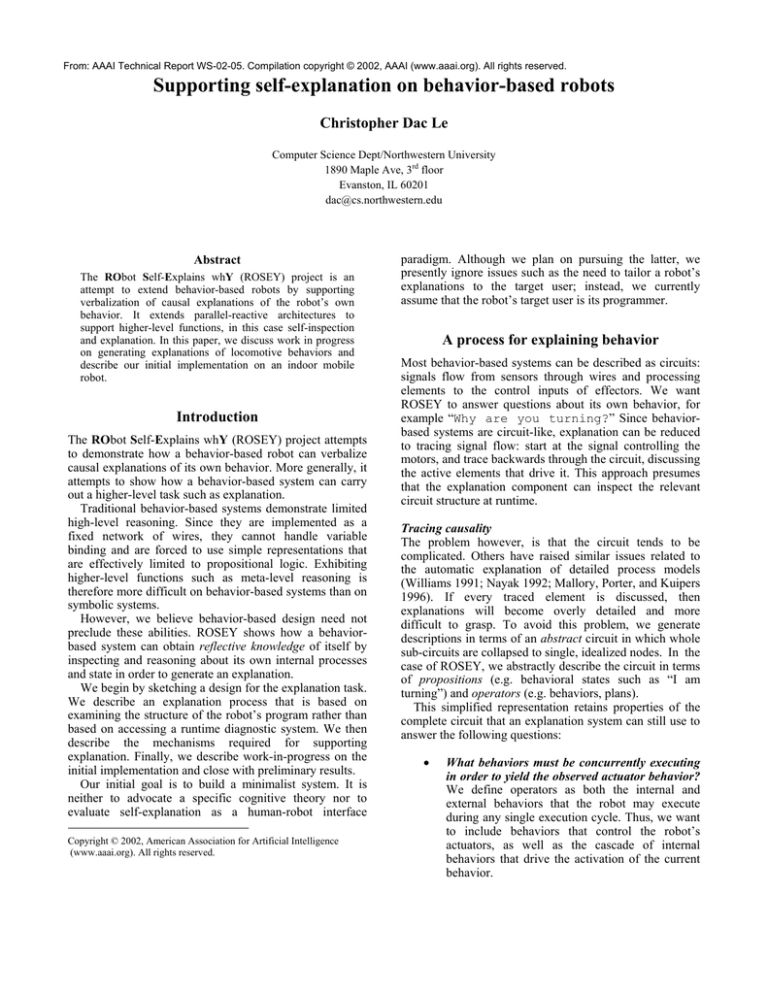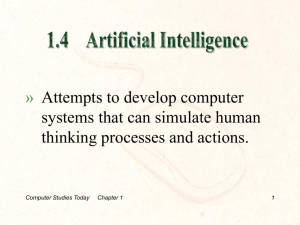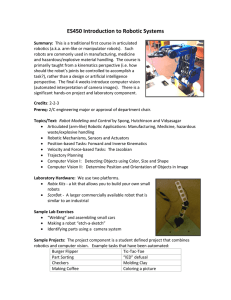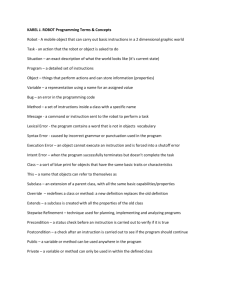
From: AAAI Technical Report WS-02-05. Compilation copyright © 2002, AAAI (www.aaai.org). All rights reserved.
Supporting self-explanation on behavior-based robots
Christopher Dac Le
Computer Science Dept/Northwestern University
1890 Maple Ave, 3rd floor
Evanston, IL 60201
dac@cs.northwestern.edu
Abstract
The RObot Self-Explains whY (ROSEY) project is an
attempt to extend behavior-based robots by supporting
verbalization of causal explanations of the robot’s own
behavior. It extends parallel-reactive architectures to
support higher-level functions, in this case self-inspection
and explanation. In this paper, we discuss work in progress
on generating explanations of locomotive behaviors and
describe our initial implementation on an indoor mobile
robot.
Introduction
The RObot Self-Explains whY (ROSEY) project attempts
to demonstrate how a behavior-based robot can verbalize
causal explanations of its own behavior. More generally, it
attempts to show how a behavior-based system can carry
out a higher-level task such as explanation.
Traditional behavior-based systems demonstrate limited
high-level reasoning. Since they are implemented as a
fixed network of wires, they cannot handle variable
binding and are forced to use simple representations that
are effectively limited to propositional logic. Exhibiting
higher-level functions such as meta-level reasoning is
therefore more difficult on behavior-based systems than on
symbolic systems.
However, we believe behavior-based design need not
preclude these abilities. ROSEY shows how a behaviorbased system can obtain reflective knowledge of itself by
inspecting and reasoning about its own internal processes
and state in order to generate an explanation.
We begin by sketching a design for the explanation task.
We describe an explanation process that is based on
examining the structure of the robot’s program rather than
based on accessing a runtime diagnostic system. We then
describe the mechanisms required for supporting
explanation. Finally, we describe work-in-progress on the
initial implementation and close with preliminary results.
Our initial goal is to build a minimalist system. It is
neither to advocate a specific cognitive theory nor to
evaluate self-explanation as a human-robot interface
Copyright © 2002, American Association for Artificial Intelligence
(www.aaai.org). All rights reserved.
paradigm. Although we plan on pursuing the latter, we
presently ignore issues such as the need to tailor a robot’s
explanations to the target user; instead, we currently
assume that the robot’s target user is its programmer.
A process for explaining behavior
Most behavior-based systems can be described as circuits:
signals flow from sensors through wires and processing
elements to the control inputs of effectors. We want
ROSEY to answer questions about its own behavior, for
example “Why are you turning?” Since behaviorbased systems are circuit-like, explanation can be reduced
to tracing signal flow: start at the signal controlling the
motors, and trace backwards through the circuit, discussing
the active elements that drive it. This approach presumes
that the explanation component can inspect the relevant
circuit structure at runtime.
Tracing causality
The problem however, is that the circuit tends to be
complicated. Others have raised similar issues related to
the automatic explanation of detailed process models
(Williams 1991; Nayak 1992; Mallory, Porter, and Kuipers
1996). If every traced element is discussed, then
explanations will become overly detailed and more
difficult to grasp. To avoid this problem, we generate
descriptions in terms of an abstract circuit in which whole
sub-circuits are collapsed to single, idealized nodes. In the
case of ROSEY, we abstractly describe the circuit in terms
of propositions (e.g. behavioral states such as “I am
turning”) and operators (e.g. behaviors, plans).
This simplified representation retains properties of the
complete circuit that an explanation system can still use to
answer the following questions:
•
What behaviors must be concurrently executing
in order to yield the observed actuator behavior?
We define operators as both the internal and
external behaviors that the robot may execute
during any single execution cycle. Thus, we want
to include behaviors that control the robot’s
actuators, as well as the cascade of internal
behaviors that drive the activation of the current
behavior.
•
What set of conditions must hold true in order to
yield the observed actuator behavior? We treat
propositions as corresponding to internal
conditions that the robot may have during any
single execution cycle. Propositions encompass
sensory-motor conditions as well as the Boolean
conditions under which an operator will be
activated.
Figure 1 illustrates how propositions and operators are
causally related: propositions affect operators that then
effect other propositions. In other words, operators can
change the truth-values of propositions, whereas
propositions may directly turn operators on or off. Tracing
causality can be reduced to a process of walking this
circuit (which we call the abstract causal circuit) and
finding the path of activated propositions and operators.
We currently assume only one active path exists through
this circuit.
Proposition
Proposition
Operator
Proposition
Operator
Proposition
Proposition
Figure 1. Abstract causal circuit. A robot circuit is
simplified to nodes consisting of either propositions or
operators.
However, we still need to formulate how to actually
generate this structure given the original robot circuit. In
particular, how do we identify a sufficient set of
propositions and operators to encode? What is the process
for mapping the elements of a behavior-based system to
this set? We are currently investigating possible answers to
these questions. For the moment, we are manually
constructing the abstract causal circuit.
If node is an operator, is it currently
running?
Possible causes
o If node is a proposition, what operators
are known to cause it to be true?
o If node is an operator, what propositions
are known to activate it?
The active cause
o If node is a proposition, which operator
is actually causing it to become true?
o If node is an operator, which proposition
is actually activating it?
o
•
•
These requirements directly translate into a corresponding
set of operations and a simple interface for retrieving this
information from the self-inspection (SI) system:
•
•
•
•
•
get-name
get-type
get-current-state
get-known-causes
compute-active-cause
A simplified explanation process
Given these mechanisms, we can now sketch a process for
generating explanations. Figure 2 illustrates a schematic
overview of this process. To initiate an explanation, the
user asks a “why” question resembling any of the
following forms:
•
•
“Why are you <symptom>?”
“Why are you in the state
<symptom>?”
Here, <symptom> is a word describing a particular robot
state (e.g. “turning” or “moving”) and corresponding to a
proposition node.
User
why are you <symptom>?
query
explanation
explanation
system
node information
Self-inspection mechanisms
The robot will require some runtime mechanisms to
operate over the abstract causal circuit. One is the means to
look up and tag an arbitrary node, given its lexical
equivalent. For example, the word “turning” should
correspond to a particular node in the circuit.
Another set of needed mechanisms involves the
extraction of both static and dynamic information
pertaining to the node. Required information includes:
•
•
•
Name
Type (proposition or operator)
Current state
o If node is a proposition, is it currently
true?
of
self-inspection
system
active-cause
symptom
abstract causal circuit
Figure 2. Schematic overview of the explanation process.
The explanation system parses the user’s question. Upon
recognizing a why question, the explanation system tags
the word representing the symptom so that the SI system
may look up the corresponding node; the SI system
references this node as the “symptom.”
At this point, the SI system tests whether the symptom
node is even active, in other words, whether the symptom
is even true. By testing the truth-value of the symptom, the
explanation system can comment on the applicability of
the user’s question. If the symptom turns out to be false,
then the explanation system can respond with an utterance
such as
“Well I don’t believe
state of <symptom>.”
I’m
in
the
On the other hand, if the symptom is true, then the SI
system proceeds to identify the active cause. First it looks
up the set of possible causes of this symptom (these are
identified a priori). It then iterates through each possible
cause, testing whether each is true. Upon knowing the
actual cause, the explanation system can then respond with
an utterance such as
“I am in the state of <symptom>
because I am trying to execute
<active-cause>.”
of the abstract causal circuit. Eventually, we will explore
different ways we may vary the depth—and degree of
detail—to which a single explanation response is
generated.
Initial implementation
Current status
We have implemented a very preliminary version of
ROSEY on an indoor 2-wheel differential-drive robot
(Figure 3) that attempts to explains its current locomotive
behavior. ROSEY currently responds to the following
queries:
•
•
•
•
Why
Why
Why
Why
are
are
are
are
you
you
you
you
turning?
stopped?
reversing?
moving?
A natural language parser separate from ROSEY
handles word recognition and serves as the interface
between the user and ROSEY. We borrow this parser from
another system called Cerebus (Horswill, Zubek, et. al.
2000).
where <active-cause> is the name of the identified cause
and in this case, corresponds to an operator node.
With this process, we assume only one node can be
active among the possible causes, which means we also
assume only one active path can be traced through the
circuit. We hope to relax this restriction as we develop
methods for constructing the abstract causal circuit.
Follow up questions
Thus far, we have described a process that generates
explanations delving only one level deep in the circuit.
However, the user may seek further detail in a follow up
question such as “Why?” This follow up question becomes
a contextual one, equivalent to saying
“Why are you doing <symptom>?”
where <symptom> is now the name of the previously
identified cause.
In order to repeat the explanation process, the SI system
re-references the previously identified active cause node as
the new “symptom.” The SI system now repeats the same
process for testing the possible causes. A subsequent
explanation can then be
“I am executing <symptom> because I
believe <active-cause> is true.”
As the user asks additional follow up questions, the
node type of each subsequent active cause will flip-flop
between proposition and operator; this reflects the nature
Figure 3. Indoor mobile robot platform
At the moment, ROSEY generates a one-level-deep
explanation, for example:
> why are you turning ?
Because ROSEY is trying
unstuck.
to
get
where turning is a locomotive symptom corresponding
to a proposition node. To minimize the mechanical quality
of the responses, we are forgoing the use of fill-in-theblank
templates
(e.g.
“I
am
executing
<symptom>”, where we substitute a node name for
<symptom>). Instead, every node in the abstract causal
circuit has a fixed—but unique—utterance stored as an
additional property. When explaining an active cause node,
the explanation system retrieves the canned response
associated with this node. For instance, in the above
example, the response “Because ROSEY is trying
to get unstuck.” has been taken from the node
representing the unwedger motor behavior, which is the
operator currently causing turning to be true.
Current issues
The
four
propositions—turning,
stopped,
reversing, and moving—attempt to be descriptive of
the locomotive qualities that a user may observe and
ascribe to the robot as it is moving around in the world.
Consequently, ROSEY recognize these words as
symptoms. We want to continue to expand the set of
recognizable symptoms.
To grow this set, we plan to introduce a second class of
queries that ROSEY understands. So far, we have
described ROSEY handling queries that pertain to its
instantaneous locomotive state. We call these queries
instantaneous queries. However, ROSEY does not handle
queries that require it to maintain history or a knowledge
of its past execution cycles. We call such queries historybased queries. This current limitation explains why
ROSEY can handle an instantaneous query like “Why
are you turning?”, while failing to recognize a
query like “Why are you oscillating?” We
acknowledge that maintaining a history of states and
actions will be a valuable part of a robot explanation
system.
As mentioned earlier, a central issue we are facing is
figuring out how to generate the abstract causal circuits.
Two questions persist. First, how do we identify a
sufficient set of propositions and operators? Second, what
is a process for mapping circuit elements to this set?
Answering the first question will be partially answered by
the kinds of symptoms we see users will want to ascribe to
the robot’s behavior.
In addressing the second question, we are currently
defining macros that permit the robot programmer to
annotate the set of propositions and operators that should
be reified for the explanation system. However, we plan to
move towards automated techniques. In particular, we are
exploring how we may leverage robot programming
languages that support circuit semantics representations
(Nilsson 1994). With such languages, we hope to more
easily map circuit-semantic robot programs to the abstract
causal circuits.
Tagged behavior-based architecture approach
To support the required runtime mechanisms, we are
building ROSEY using a tagged behavior-based
architecture called role-passing (Horswill 2001; Horswill
1998). In role-passing, tags are linguistic roles such as
“cause” and “symptom”. By using a tagged behavior-based
architecture like role-passing, we gain two advantages.
First, we are able to implement variable-binding, allowing
us to construct higher-ordered behaviors such as the selfinspection tests. Because tags can be reassigned, the SI
system is able to redirect the same computational
mechanisms to different nodes in the circuit.
For instance, the SI system references the symptom node
through the symptom tag. It then tests whether the node
referenced by symptom is active or not. Later on, the SI
system can quickly rebind the symptom tag to a different
node and repeat the very same test.
Second, we are using role-passing in order to reuse
some pre-existing infrastructure; this includes the
mechanism for looking up arbitrary nodes in the circuit as
well as the “active” tests performed on an individual
proposition or operator.
Related systems
ROSEY is an extension of the Cerebus project (Horswill
2001; Horswill, Zubek, et. al. 2000), a system that is able
to discuss its capabilities and internal structures. This work
attempts to extend this ability by enabling the robot to
explain how its processes and state dictate its current
behavior.
ROSEY is part of a larger category of question-andanswer robots. One of those robots includes (Torrance
1994), who describes a robot that can answer questions
about navigational plans and about the spatial relationships
that hold between known places. KAMRO is a two-armed
mobile assembly robot that can explain its own error
recovery methods to a human supervisor (Längle, Lüth,
Stopp, and Herzog 1996).
ROSEY is also part of a category of work that involves
explanation of physical systems. A variety of work has
been done, many in the context of diagnosis, instruction,
and engineering design. Self-explanatory simulators
(Forbus and Falkenhainer 1990) represent one large class
of software that permits the user to seek causal
explanations of physical processes being modeled. One
system that shares similar purposes as ROSEY is described
in (Gautier and Gruber 1993). Their task is to respond to
behavior-related queries about a physical device by
automatically generating causal explanations from a
model. They attempt to avoid overly detailed explanations
by applying a few heuristics for selecting salient details.
We will consider similar heuristics for constructing our
circuit.
Conclusion
First, ROSEY is an attempt to demonstrate how a
behavior-based robot can verbalize explanations of its own
behaviors. More generally, it attempts to show how a
parallel-reactive architecture can support a higher-level
task such as explanation. Although this work is still
preliminary, we believe a behavior-based system can be
just as capable as a symbolic system at accomplishing such
a task. In particular, we show that behavior-based robots
can obtain reflective knowledge through self-inspection.
We also view ROSEY as representative of an emerging
category of self-explanatory robots. We are interested in
increasing the reliability and cooperativeness of behaviorbased robots. Although this issue has been beyond the
scope of this paper, we feel that self-explanatory robots
will demonstrate an important trait. By revealing their
internal states and processes, such robots will be better
understood and accepted by human users, whether the
person is an expert robot programmer or a novice user.
Eventually, as mobile robots become more commonplace,
even greater interest will be placed on robots that are easy
to use, easy to diagnose, and easy to maintain. Selfexplanatory robots will be in service of those goals.
References
Forbus, K. and Falkenhainer, B. (1990). Self-explanatory
simulations: An integration of qualitative and quantitative
knowledge. In Proceedings of the Eighth National
Conference on Artificial Intelligence, Boston, MA., AAAI
Press/MIT Press, 1990, 380-387.
Gautier, P.O. and Gruber, T.R. (1993). Generating
explanations of device behavior using compositional
modeling and causal ordering. In Proceedings of the
Eleventh National Conference on Artificial Intelligence,
Washington, D.C., AAAI Press/MIT Press, 1993.
Horswill, I. (2001). Tagged behavior-based architectures:
Integrating cognition with embodied activity. IEEE
Intelligent Systems. September/October 2001: 30-38.
Horswill, I., Zubek, R., et. al. (2000). The Cerebus project.
AAAI Fall Symposium on Parallel Cognition. Cape Cod,
MA, November 2000.
Horswill, I. (1998). Grounding mundane inference in
perception. Autonomous Robots, 5: 63-77.
Längle, T., Lüth, T.C., Stopp, E., and Herzog, G. (1996).
Natural language access to intelligent robots: Explaining
automatic error recovery. In Artificial Intelligence:
Methodology, Systems, and Applications (Ed. A.M.
Ramsay). Amsterdam: IOS, 259-267.
Mallory, R.S., Porter, B.W., and Kuipers, B.J. (1996).
Comprehending complex behavior graphs through
abstraction. In Tenth International Workshop on
Qualitative Reasoning about Physical Systems, Fallen Leaf
Lake, CA, 1996, 137-146.
Nayak, P.P. (1992). Causal approximations. In
Proceedings of the Tenth National Conference on Artificial
Intelligence, San Jose, CA., AAAI Press/MIT Press, 1992,
703-709.
Nilsson, N. (1994). Teleo-reactive programs for agent
control. Journal of Artificial Intelligence Research, 1: 139158.
Torrance, M. (1994). Natural communication with robots.
Master’s Thesis. MIT. Cambridge, MA.
Williams, B.C. (1991). Critical abstraction: Generating
simplest models for causal explanation. In Proceedings of
the Fifth International Workshop on Qualitative Reasoning
about Physical Systems, 1991.




